Choosing the right platform can make all the difference. Between the two popular eCommerce platforms, Shopify vs WooCommerce, which one should you choose? Let’s embark on an in-depth comparison of their features, pricing, and capabilities to help you make an informed decision.
Key Takeaways
- Shopify and WooCommerce offer extensive platform ecosystems, with Shopify providing a curated selection of apps that integrate seamlessly, and WooCommerce utilizing the WordPress plugin library for users to customize their store.
- Both platforms provide customers with diverse payment gateway options as well as tools to promote products. WooCommerce offers more customization options and flexibility than Shopify.
- Shopify provides comprehensive customer support including 24/7 service while WooCommerce has community forums for assistance.
The face-off: Shopify store vs WooCommerce store

As two leading eCommerce platforms, Shopify and WooCommerce both offer a range of features for setting up and managing online stores. Shopify is a hosted solution, providing an all-in-one package for your eCommerce store, while WooCommerce is a self-hosted plugin built for WordPress. This fundamental difference in their architecture leads to variations in their offerings, pricing, and overall user experience.
When choosing an eCommerce platform, you should consider factors like order tracking and inventory management. Shopify boasts a wealth of integrated features, while WooCommerce relies on additional expenditures for certain features on your WordPress site.
So, which platform is more suitable for your online store? We’ll examine this further.
Hosted vs self-hosted solutions
Shopify is a hosted platform, offering an all-in-one solution that handles the technical aspects of running an online store for you, including hosting, website design, and payment processing. With basic Shopify, you can focus on growing your business without having to worry about the technicalities of managing your online store. The downside to using a hosted platform is that you have limited control over the technical aspects of your store.
On the other hand, WooCommerce is a self-hosted platform that requires a hosting account and domain name, as well as the management of your online store by the user. This provides increased control over the technical aspects of your store and allows for more customization options. But, this also means that you are responsible for managing the technical aspects of your store, including hosting, website design, and payment processing.
Ultimately, the choice between a hosted and self-hosted solution depends on your preferences and needs. If you value simplicity and ease of use, Shopify may be the better choice for you. For those who have greater control and flexibility in your online store as your main concerns, WooCommerce might be the way to go.
Platform ecosystems
Both Shopify and WooCommerce have extensive ecosystems to enhance your eCommerce store. Shopify offers a curated Shopify App Store with a wide range of third-party add-ons and integrations, while WooCommerce leverages the extensive WordPress plugin library. Shopify’s App Store may have fewer options than WooCommerce’s plugin library, but the applications are carefully selected and integrate seamlessly with your store.
The official WordPress directory contains a great selection of plugins for WooCommerce, one of the popular eCommerce platforms. In addition, WooCommerce integrations are widely available, making it easy to enhance store functionality with a variety of third-party tools and plugins. Shopify, on the other hand, offers more than 8,000 apps and extensions in its app store, which are made for various eCommerce needs.
In summary, both platforms provide a range of options to enhance your eCommerce store. While Shopify offers a carefully curated selection of apps that integrate seamlessly with your store, WooCommerce leverages the extensive WordPress plugin library, giving users access to thousands of plugins to customize their store to their liking.
🚀 Quick takeaway
Shopify provides ease and built-in security, perfect for quick setups. WooCommerce offers greater customization but requires more hands-on management.
Also read:
Magento vs Shopify eCommerce Platform Comparison
Setting up your online shop
Setting up an online store with Shopify is generally quicker and more straightforward than using WooCommerce. Shopify offers an intuitive onboarding process and handles most technical aspects for you, making it a more user-friendly option for beginners. In contrast, WooCommerce requires more technical knowledge and setup steps, as well as familiarity with WordPress to get started. Additionally, WooCommerce users often need to install plugins to add features that Shopify provides out of the box.
We’ll examine the setup processes for both platforms more closely.
Getting started with Shopify
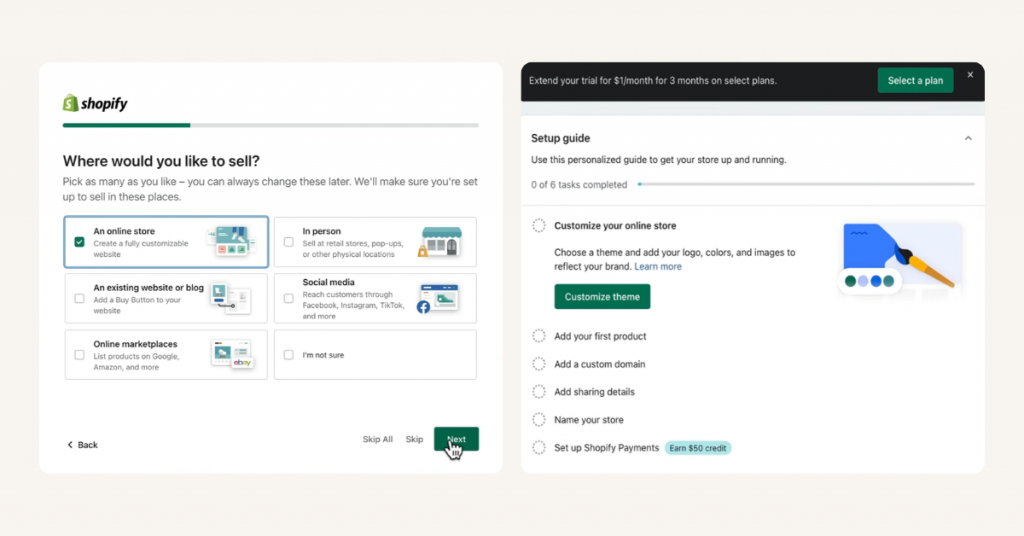
Shopify offers a user-friendly interface and quick store setup. After enrolling for an account, users can access the Shopify dashboard for a convenient setup guide and begin customizing their store. Shopify is a fully hosted platform, so there is no need for installation, management, or software updates. Additionally, security, performance, backups, and compatibility are all taken care of.
Once your Shopify store is set up, you can easily add and manage your products by navigating to the Products section in the Shopify dashboard, selecting the “Add your products” button, and inputting your shipping, inventory, and pricing details. This streamlined process makes it easy even for first-time users to create and manage their online store. If you have more questions about setting up your Shopify store, check out our article of frequently asked questions about setting up a Shopify store.
Also read:
Beginners Handbook for Shopify Store Setup
Launching a WooCommerce site
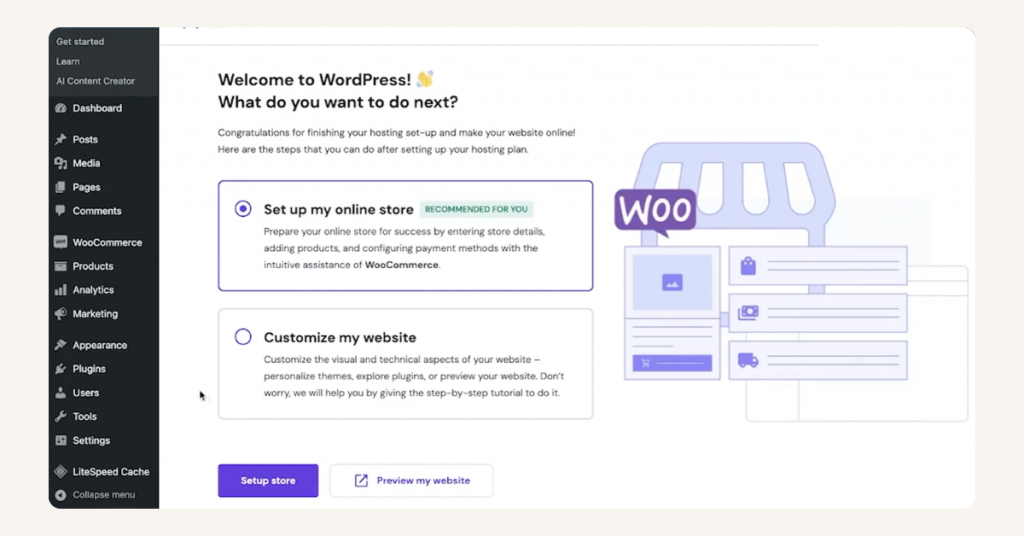
Launching a WooCommerce store involves a few more steps than setting up a Shopify store. First, you’ll need to purchase web hosting, install the WooCommerce platform for free, and potentially acquire a premium theme and extensions. This process may require a bit more technical knowledge than setting up a Shopify store, but it offers more customization options and flexibility in return.
To set up a WooCommerce store, you’ll need to:
- Install the WooCommerce plugin on your WordPress website
- Launch the quick setup wizard or navigate to the Dashboard > WooCommerce > Home
- Once your store is set up, all WooCommerce settings will be accessible from the WordPress dashboard, allowing you to manage your online store with ease.
🚀 Quick takeaway
If you need quick, hassle-free setup, choose Shopify, as it offers built-in technical management. WooCommerce provides deeper customization but requires technical skills and familiarity with WordPress.
Customization capabilities and themes

When it comes to customization capabilities, WooCommerce offers more options and themes than Shopify. With thousands of WooCommerce themes available for use with WordPress and WooCommerce, you’ll have a wide range of design choices to create your ideal online store. You can also customize existing themes to achieve a tailored store design, building upon their foundation to meet specific needs. Conversely, Shopify provides a smaller but polished selection of themes, with a user-friendly editor and liquid code for easy customization. If you’re considering Shopify, explore our detailed guide on the best Shopify themes for eCommerce to help you choose the perfect theme for your store.
We’ll examine the theme availability, variety, and customization options offered by both platforms more closely.
Theme availability and variety

WooCommerce has access to thousands of themes through the WordPress platform, offering a great range of design options to fit any eCommerce store’s needs. In addition, WooCommerce provides a wide selection of free themes, making it a cost-effective option compared to Shopify, which has only a few free themes available. Some noteworthy themes offered by WooCommerce include:
- Astra
- Flatsome
- Avada
- Uncode
- Woostify
These themes provide a range of features and customization options to optimize your online store.
In contrast, Shopify offers more than 220 themes, including both free and premium options. While this may seem like a limited selection compared to WooCommerce, the themes offered by Shopify are polished and designed to integrate seamlessly with the platform, ensuring a consistent and professional look for your online store.
Customizing eCommerce experience
Both WooCommerce and Shopify allow for customization of your eCommerce store, but WooCommerce provides more flexibility due to its open-source nature.
For example, with WooCommerce, users can:
- Modify their store’s body content
- Customize URLs
- Edit meta descriptions
- Add alt tags to images
- Customize other on-page elements
Advanced WooCommerce modifications
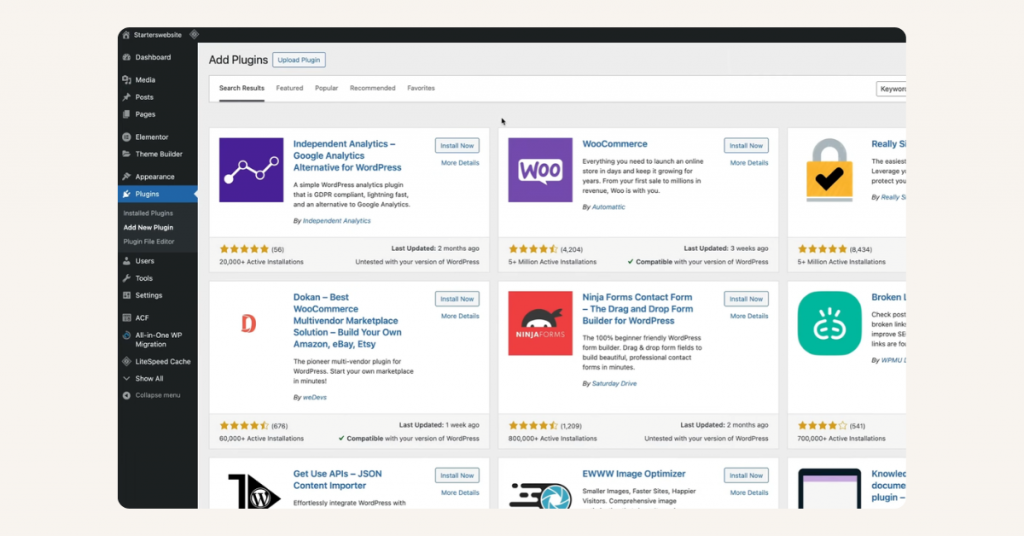
WooCommerce offers access to over 59,000 WordPress plugins, including 800+ official WooCommerce extensions, making it ideal for specialized business requirements. Additionally, WooCommerce provides complete access to its codebase and thus allows extensive customization, including modifying checkout flows, integrating ERP systems, and creating specialized functionalities. However, this requires custom development and ongoing maintenance.
Shopify’s ease-of-use and built-in tools
On the other hand, Shopify offers basic built-in SEO features, a user-friendly theme editor, and uses Liquid code for easy customization. Users can easily adjust their store’s layouts, colors, and fonts through Shopify’s intuitive interface. For more advanced customizations, editing Shopify’s Liquid template files or installing apps from its extensive App Store (with over 8,000 apps) is necessary. Some advanced features, such as checkout customizations, are restricted to Shopify’s higher-tier plan, Shopify Plus (approximately $2,000/month).
Shopify also includes built-in features such as Collections and gift cards, enhancing your store’s functionality. Although Shopify’s selection of themes may be smaller, they integrate seamlessly with your store, ensuring a consistent and professional look.
🚀 Quick takeaway
Choose WooCommerce for extensive customization and full design control. Shopify is best if you prefer ease-of-use, polished themes, and built-in features, with deeper customizations available through higher-tier plans or apps.
Payment processing comparison
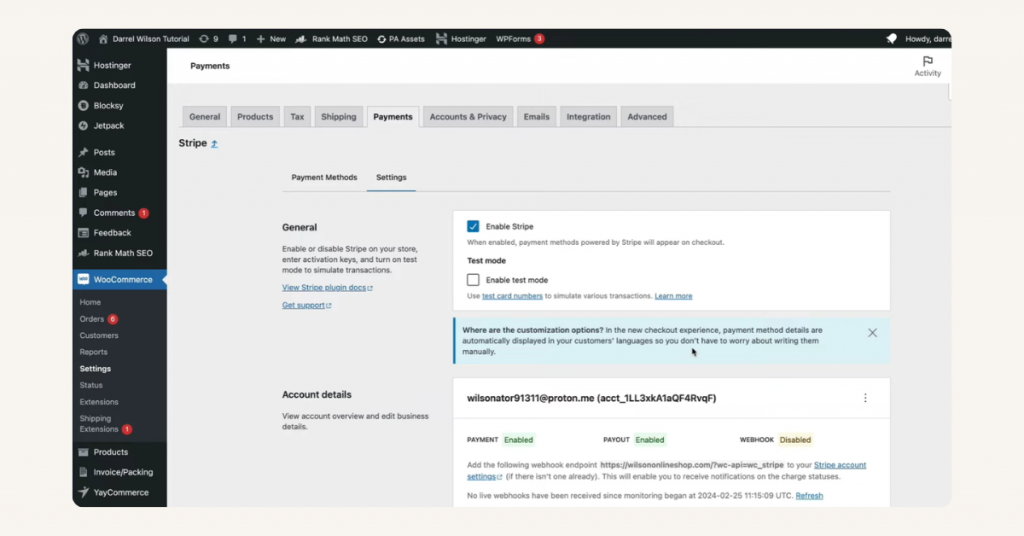
Both Shopify and WooCommerce support multiple payment gateways, catering to various customer preferences. Both platforms also allow merchants to integrate and manage multiple payment methods, providing flexibility and enhancing customer convenience. Shopify charges additional fees for external gateways, while WooCommerce offers more flexibility without extra charges.
Both platforms offer a range of payment gateways, including popular options like Shopify Payments, Stripe, PayPal, and more. This ensures that your customers have a variety of payment methods to choose from, increasing the likelihood of a successful transaction and a smooth checkout experience.
Understanding transaction fees
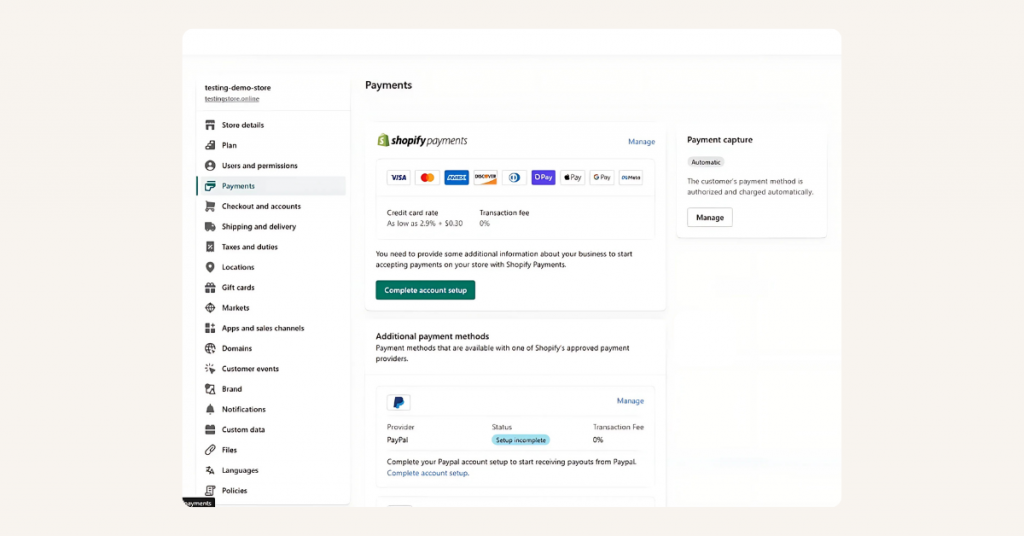
Shopify charges additional fees for using external payment gateways, starting at 2% per transaction on the Basic plan, plus the payment gateway’s own fees (typically around 2.9% + $0.30 per transaction). In contrast, WooCommerce itself does not impose extra fees for using external gateways—you only pay the standard transaction fees charged by your selected payment processor (e.g., 2.9% + $0.30 per transaction via Stripe or WooPayments).
This difference in transaction fees can be a deciding factor for some eCommerce store owners. If you prefer to use a specific payment gateway and want to avoid additional fees, WooCommerce may be the better choice. If you’re willing to use Shopify Payments or don’t mind the extra fees, Shopify’s built-in security features and seamless integration may outweigh the additional costs.
🚀 Quick takeaway
WooCommerce offers flexible payment options without extra fees. Shopify provides seamless integration and convenience with Shopify Payments, making its additional costs worthwhile if you value ease and built-in security.
Marketing and sales tools
Both Shopify and WooCommerce offer marketing and sales tools, but they differ in their approach and offerings. Shopify has built-in marketing features like Collections and gift cards, while WooCommerce offers a wide range of plugins for various marketing tasks, such as email campaigns and discount codes. In addition to free options, WooCommerce users can access premium plugins that provide advanced marketing features, enabling more sophisticated campaigns and enhanced sales strategies.
Promoting your products
Both platforms provide tools for promoting products. Shopify offers features like email campaign applications and discount codes to stimulate sales. Similarly, WooCommerce users can utilize plugins like Smart Coupons to create tailored offers for particular customer segments, drawing in new customers and reactivating dormant ones.
The choice between Shopify and WooCommerce for product promotion depends on your specific needs and preferences. Shopify provides a more streamlined experience, while WooCommerce offers more flexibility and customization options through plugins.
Enhancing sales tactics
When comparing WooCommerce vs Shopify, both platforms offer sales-enhancing features, but they differ in their approach. Shopify provides tools like abandoned cart recovery, discount codes, and payment flexibility, while WooCommerce has more customization options through plugins like OptinMonster and TrustPulse.
In the end, your decision between the two platforms to improve sales strategies will be influenced by your specific requirements and business objectives.
🚀 Quick takeaway
Shopify offers user-friendly marketing tools for quick results, while WooCommerce allows deeper customization through specialized plugins.
Optimizing your eCommerce store
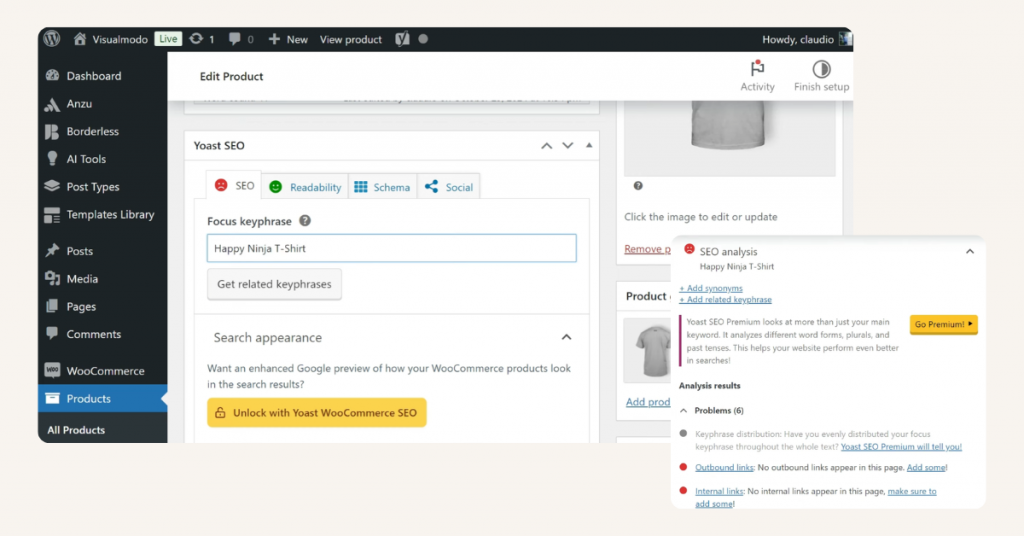
WooCommerce has better SEO capabilities due to its open-source nature and access to WordPress plugins, while Shopify offers basic built-in SEO features. Using an SEO plugin such as Yoast SEO or All in One SEO Pack can further enhance search engine optimization for WooCommerce stores by providing advanced tools for managing meta tags, sitemaps, and other SEO elements. Search engine optimization is a crucial factor in driving organic traffic to your online store and improving its visibility on search engines like Google.
Built-in SEO features
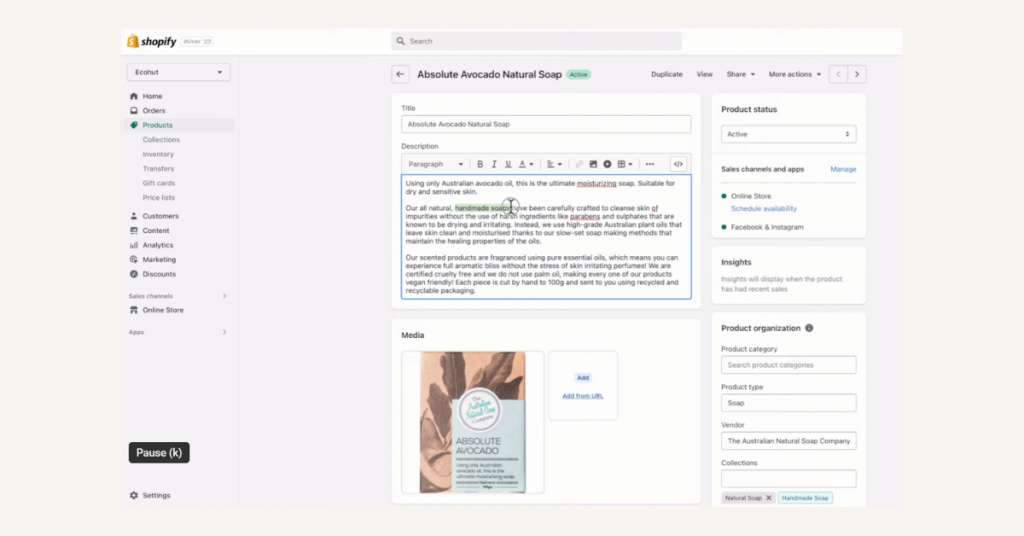
Both Shopify and WooCommerce have built-in SEO features. Shopify provides basic SEO support, including meta information and site copy, while WooCommerce offers powerful SEO tools, including the ability to modify body content, URLs, meta descriptions, alt tags, and other on-page elements.
In terms of built-in SEO features, WooCommerce has the edge over Shopify due to its flexibility and control over SEO elements. However, Shopify’s built-in features may be sufficient for smaller businesses or those with less complex SEO needs.
Check out how scandiweb improved Mrs Wordsmith’s SEO strategy here: case study.
Leveraging SEO plugins
WooCommerce leverages WordPress plugins for advanced SEO, giving users access to popular SEO plugins like Yoast SEO and The SEO Framework. On the other hand, Shopify has a limited selection of SEO plugins available in its app store.
The availability of these plugins provides WooCommerce users with more flexibility and customization options in optimizing their eCommerce store for search engine visibility.
Technical SEO control
Shopify manages essential SEO tasks automatically, including generating XML sitemaps, canonical tags, structured data markup, and ensuring responsive themes optimized for mobile performance. Its interface makes handling meta tags and redirects straightforward. However, Shopify does limit some advanced SEO customizations. For example, users cannot fully control URL structures (such as removing the mandatory “/products/” prefix), deeply modify blog permalink formats, or extensively customize robots.txt files.
WooCommerce offers complete technical SEO control. You can freely adjust URL structures, directly edit important configuration files and utilize powerful SEO plugins such as Yoast SEO, Rank Math, or All in One SEO. These plugins allow detailed control of meta data, structured data, indexing settings, and bulk SEO edits. WooCommerce also takes advantage of WordPress’s robust blogging platform, which greatly supports content-driven SEO strategies. However, effectively managing these advanced features requires ongoing attention, technical expertise, and careful monitoring to prevent errors or performance issues.
🚀 Quick takeaway
WooCommerce excels for deep SEO control; Shopify suits simpler, built-in SEO with minimal effort.
Inventory management: Keeping track of stock
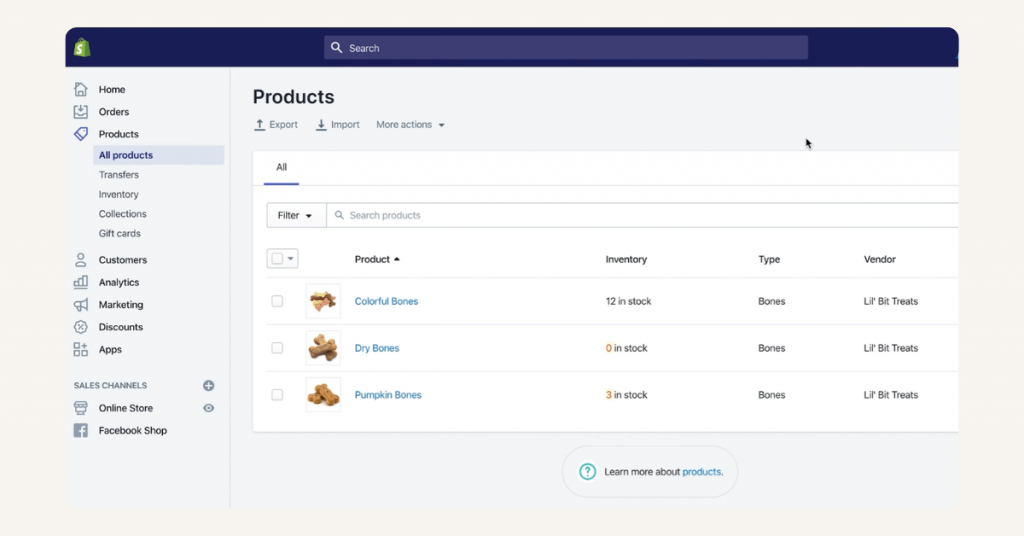
Both Shopify and WooCommerce offer inventory management features, but WooCommerce provides more flexibility and scalability for growing businesses. Both platforms also support a variety of courier shipping options, such as USPS, UPS, and FedEx, allowing you to efficiently fulfill customer orders. With WooCommerce, you can manage product variants and stock organization, as well as track inventory levels and sales trends.
Product variants and organizing stock
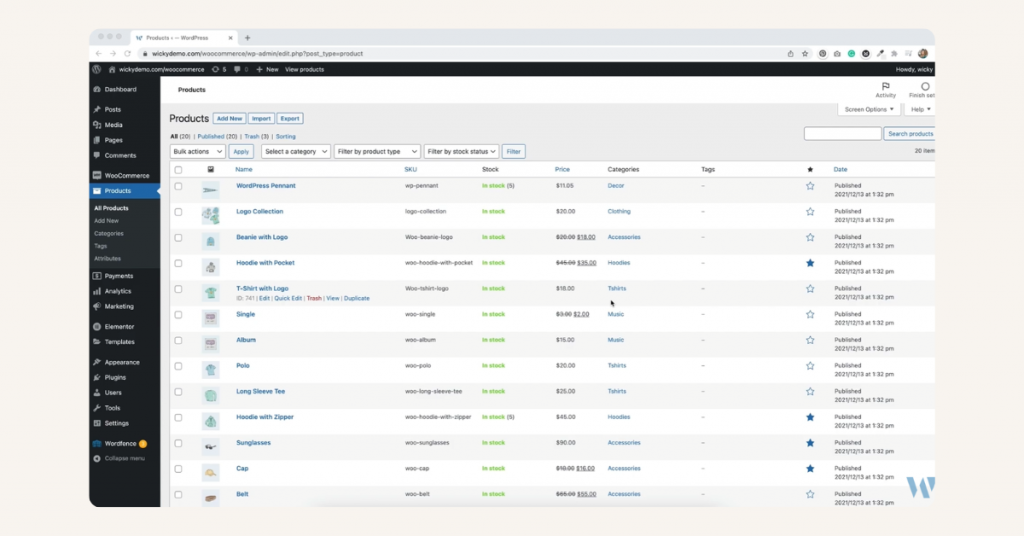
Both platforms allow for product variant management and stock organization. Shopify provides inventory management features that enable you to monitor inventory levels for products and variants and link your products and variants to inventory items. WooCommerce, on the other hand, enables you to configure variations for each product, such as color or size, with their own prices and inventory levels.
Organizing product variants and stock on both platforms can be achieved through:
- Prioritizing
- Providing clear and concise names
- Incorporating product images
- Categorizing products logically using collections or categories.
🚀 Quick takeaway
Choose Shopify for simple, reliable inventory management. WooCommerce is ideal for extensive variants and flexible scalability.
Performance and scalability for growing businesses
Both platforms can handle expansion, but they differ significantly in their infrastructure, management requirements, and overall ease of scalability.
Shopify’s performance and seamless scalability
Shopify offers effortless performance and scalability. As a fully-hosted platform, Shopify automatically manages infrastructure and scaling. During peak events like Black Friday 2024, Shopify processed $4.2 million per minute without issues. In 2025, Shopify introduced AI-based optimizations to maintain consistently fast load times.
Currently, Shopify supports 100 variants per product (up to three options each), with plans to expand to 2,000 variants per product later in 2025.
However, Shopify’s limitations may not be a concern for smaller businesses or those with less complex product offerings.
To maximize your Shopify store’s performance, explore our detailed guide on Shopify Performance Optimization for practical tips and strategies.
WooCommerce’s flexible yet resource-dependent scalability
WooCommerce offers more scalability options than Shopify, as it is more flexible and can handle sudden increases in traffic and the addition of new pages and products.
Simply put, WooCommerce has the edge over Shopify due to its open-source type and access to a large gallery of plugins and extensions. But it requires proactive optimization. With suitable hosting, WooCommerce handles 100,000+ SKUs and thousands of transactions per minute. Achieving this requires:
- Selecting high-performance, managed WordPress hosting with built-in caching and CDN features
- Optimizing performance with caching plugins (WP Super Cache, LiteSpeed Cache), image compression, and lightweight themes
- Proactively increasing server capacity and resources ahead of anticipated traffic peaks.
🚀 Quick takeaway
Shopify offers simple, reliable scalability. WooCommerce provides flexibility but needs active management.
Security standards, fraud protection, and compliance
Ensuring the safety of your eCommerce store is essential to protect customer data and maintain trust.
Platform security
Shopify has built-in security features, including:
- SSL certificate
- PCI compliance
- Fraud analysis
- Secure payment gateways
WooCommerce, being self-hosted, places the security responsibilities directly on the store owner. While WooCommerce itself is not PCI-certified, you can achieve compliance through secure hosting and using third-party payment gateways like Stripe or PayPal.
Additionally, WordPress 6.4 also introduced automatic updates for plugins and core software, reducing manual patching for WooCommerce site owners, though active monitoring remains essential.
Ensuring safe transactions and fraud protection
Both Shopify and WooCommerce ensure safe transactions for their users. Shopify provides built-in security features such as 3D Secure authentication, secure payment options, and account security best practices. WooCommerce, on the other hand, relies on secure hosting providers and supplementary plugins for enhanced security, as well as adhering to PCI-DSS compliance and implementing security measures such as vigilant monitoring and specialized plugins.
In terms of transaction security, Shopify is a frontrunner with its built-in security features, while WooCommerce needs additional measures to ensure the safety of its users.
Compliance (PCI DSS, GDPR, and taxes)
Shopify simplifies compliance significantly:
- PCI DSS Level 1 compliant by default
- Easy handling of GDPR requirements (e.g., exporting and deleting customer data on request)
- Holds SOC 1, 2, and 3 certifications
- Built-in tools for streamlined U.S. sales tax calculations and reporting.
For WooCommerce, compliance responsibility fully rests on the store owner. PCI DSS compliance typically involves using secure third-party gateways and self-attesting via questionnaires or conducting security scans. GDPR compliance and tax calculations generally require manual configurations or plugins.
Maintaining a secure online presence
WooCommerce requires additional measures for maintaining a secure online presence, including:
- Selecting a secure host
- Installing an SSL certificate
- Adhering to PCI-DSS compliance
- Implementing security measures such as monitoring and specialized plugins.
Shopify provides built-in security features. These features ensure the security of your store from cyberattacks, malware infections, and hacking attempts.
While both platforms take security seriously, Shopify’s built-in security features offer a more comprehensive solution, making it easier for store owners to focus on growing their business without worrying about maintaining a secure online presence.
🚀 Quick takeaway
Shopify offers built-in security, fraud protection, and easy compliance, perfect for hassle-free management. WooCommerce provides flexibility but demands proactive setup and ongoing attention.
WooCommerce vs Shopify pricing structures: What will your online store cost?
Shopify has transparent pricing plans, while WooCommerce cost is variable and depends on several factors such as hosting, themes, and plugins. Hosting costs are a significant component of WooCommerce’s total expenses, and these can increase as your store grows. The total cost and complexity of WooCommerce depends on choices like hosting providers, extensions, and the level of customization you require. Understanding the pricing structures of both platforms can help you make an informed decision about which platform is best suited for your eCommerce store.
Subscription models vs. free plugin approach
Shopify offers subscription plans ranging from $5 per month (Starter plan for selling via social media and messaging apps) up to $399 per month (Advanced plan), providing a clear pricing structure for users. The standard online store plans typically chosen by most merchants start at $39 per month (Basic Shopify) or $105 per month (Shopify).
On the other hand, WooCommerce is a free plugin but requires additional costs for hosting, domain name, and security. This means that the total cost of ownership for a WooCommerce store can vary depending on the hosting plan, themes, and plugins selected.
When comparing subscription models, Shopify provides a more straightforward pricing structure, while WooCommerce offers more flexibility with its free plugin approach.
Calculating and comparing Total Cost of Ownership (TCO)
Total ownership costs vary for both platforms, with Shopify having set plans and WooCommerce having variable costs. Shopify’s plans start at $39 per month, covering essential services such as hosting and security, with additional transaction fees starting from 2.9% plus extra fees. Additional transaction fees apply if external payment gateways are used, though these fees can be avoided with Shopify Payments.
In contrast, WooCommerce is a free and open-source plugin, but entails variable costs depending on the plugins, themes, and extensions selected, as well as the hosting plan chosen. While WooCommerce doesn’t add extra platform transaction fees, expenses can vary significantly based on the chosen hosting provider, premium themes, plugins, and ongoing maintenance requirements
Ultimately, the total ownership costs of both platforms depend on your specific needs and requirements. Shopify’s set plans may be more suitable for businesses looking for a predictable pricing structure, while WooCommerce’s variable costs offer more flexibility and customization options. This is why Shopify claims its total cost of ownership is approximately 36% lower on average compared to WooCommerce, largely due to WooCommerce’s variable expenses.
🚀 Quick takeaway
Ultimately, the decision between Shopify vs WooCommerce comes down to choosing between Shopify’s simplified and predictable costs or WooCommerce’s flexible, though less predictable, pricing structure.
Refer to the table below for a detailed breakdown of WooCommerce vs Shopify pricing:
| Cost category | Shopify | WooCommerce |
| Platform cost | $39/month (Basic plan). Higher tiers: $105 or $399/month. | Free and open-source plugin. |
| Hosting | Included in all plans (no extra cost). | Not included. $10–$50/month depending on provider and performance. |
| Domain name | ~$14/year through Shopify (varies). | ~$10–$20/year depending on registrar. |
| SSL certificate | Included. | Free with some hosts or up to ~$65/year if purchased separately. |
| Transaction fees | 2.9% + $0.30 per transaction via Shopify Payments. +2.0% fee for external gateways on Basic plan. | Depends on payment gateways. No added platform transaction fees. |
| Themes | 13 free themes. Paid themes: ~$100–$500 one-time fee. | Free and premium themes. Paid themes: ~$50–$130 one-time fee. |
| Apps / plugins | 8,000+ apps. Many are free; paid ones typically $10–$100/month each. | Thousands of plugins. Some are free; premium extensions: $0–$200/year per plugin. |
| Maintenance & customization | Included in subscription. Shopify manages security, updates, and infrastructure. | Site owner responsible for updates, security, and long-term maintenance. May need to hire developers. |
| Scalability costs | Built-in scaling and CDN with no extra cost. | Hosting and performance upgrades needed as traffic or product volume grows. |
| Predictability | High – monthly pricing is consolidated and easy to forecast. | Variable – depends on chosen tools, hosting, and scaling needs. |
| Estimated TCO (annual) | ~$1,000–$5,000/year depending on plan, transaction volume, and number of apps. | ~$369/year for a basic setup. Can reach $1,000+/year for full-featured stores (excluding dev/consulting). |
Support systems: Navigating challenges in eCommerce
Shopify offers better customer support – 24/7 live chat, email, scheduled phone callbacks, and its AI assistant Sidekick for in-dashboard guidance. WooCommerce relies on community forums and professional assistance. Accessing help and resources can be crucial when navigating the challenges of eCommerce, and the support systems provided by both platforms can influence your choice.
For WooCommerce stores, web designers or agencies can help manage hosting and technical support, offering expertise and scalable solutions tailored to different client needs.
We’ll look at the customer support options available for Shopify and WooCommerce users.
Accessing help and resources
Shopify offers comprehensive customer support through its acclaimed support team, live chat, email, and the Shopify Community. Additionally, they provide a wealth of resources, such as programming language toolkits, tutorials, and guides on optimizing website traffic with advanced Shopify techniques.
WooCommerce provides customer support assistance through various channels, such as:
- Official WooCommerce Support Forum
- Reddit WooCommerce Forum
- Quora
- WordPress WooCommerce Forum
- WooCommerce on Slack
- Facebook Groups
While the community forums and groups can provide valuable insights and assistance, they may not offer the same level of dedicated support as Shopify’s customer service team.
Community and professional assistance
WooCommerce users can access community forums and professional assistance for support, but Shopify offers a more comprehensive support system, including 24/7 customer service for users via live chat and email. Depending on your specific needs and preferences, the level of support and assistance provided by each platform may be a deciding factor in your choice.
🚀 Quick takeaway
Shopify excels with immediate, 24/7 support via live chat and email. WooCommerce relies on community forums and professional resources, requiring more self-service.
Dropshipping dynamics: WooCommerce Dropshipping vs Shopify Lite
Comparing dropshipping features in WooCommerce and Shopify, Shopify offers a more user-friendly experience and WooCommerce provides more customization options and flexibility. Dropshipping can be a profitable business model for eCommerce store owners, and the features offered by both platforms can significantly impact the growth and scalability of your eCommerce business. We’ll examine the dropshipping dynamics of WooCommerce and Shopify Starter plan.
WooCommerce Dropshipping allows for more customization options and flexibility, while Shopify’s entry-level Starter plan provides a more user-friendly experience with its built-in dropshipping features, such as integration with Facebook, Amazon, eBay, and Pinterest. While Shopify’s Starter plan supports a buy button, but most dropshippers use Basic or higher to access dedicated dropshipping apps.
The choice between the two platforms for dropshipping depends on your specific needs and preferences, with Shopify offering a more streamlined experience and WooCommerce providing greater flexibility and customization options.
Mobile commerce support
Nowadays, ensuring a smooth shopping experience on mobile is crucial. Both platforms offer strong mobile capabilities, but differ notably in their ease of use and built-in features.
Mobile responsiveness and user experience
Shopify provides mobile-friendly experiences effortlessly. All Shopify themes are responsive and optimized for mobile, ensuring smooth browsing and quick checkouts with integrated options like Shop Pay, Apple Pay, and Google Pay.
WooCommerce’s mobile experience depends on your selected WordPress theme. Popular responsive themes (Storefront, Astra, Divi) deliver excellent mobile usability, but choosing and optimizing these themes is your responsibility. Mobile payments (Apple Pay, Google Pay) require additional extensions like WooCommerce Payments or Stripe.
Mobile apps and native functionality
Shopify offers a powerful merchant app (iOS/Android) for managing products, orders, and customers on-the-go. Additionally, the consumer-focused Shop app combines multiple Shopify stores in one place, driving significant mobile traffic and sales.
WooCommerce provides its own merchant app (iOS/Android) for mobile store management, but lacks a centralized consumer shopping app. Creating a customer-focused mobile app requires third-party services or custom development, adding complexity and cost.
🚀 Quick takeaway
Shopify delivers seamless mobile responsiveness and built-in merchant and consumer apps out-of-the-box, while WooCommerce provides similar potential but demands extra setup and customization.
Conclusion: WooCommerce vs Shopify—which is better for your business?
In conclusion, both Shopify and WooCommerce are powerful eCommerce platforms with their own unique features and capabilities. Shopify provides a more user-friendly, hosted solution with built-in security and support, while WooCommerce offers greater flexibility and customization options through its open-source nature and access to the extensive WordPress plugin library.
When deciding on the best eCommerce platform for your business, consider whether you value ease of use and integrated security (Shopify) or full control and customization (WooCommerce).
Ultimately, the choice between the two platforms depends on your specific needs, preferences, and business goals. So, which platform will you choose for your online store?
Frequently Asked Questions
Is it better to use Shopify or WooCommerce?
Shopify offers easier setup, enhanced security, and great themes and designs. WooCommerce is a great tool for those who seek more customization options with a variety of WordPress plugins. The choice between two great platforms should be based on the specific needs of your eCommerce store.
Is WooCommerce still relevant?
WooCommerce is still relevant and offers reliable tools and customizable solutions to make selling easier. Since the flexible, open-source platform is affordable and keeps businesses agile, it still powers a sizable slice of the market (~20 % of all eCommerce sites), however Shopify’s growth has narrowed the gap considerably.
How do the pricing structures of Shopify and WooCommerce compare?
Shopify provides transparent pricing with monthly subscriptions ranging from $39 to $399. The Basic plan covers essential features like secure hosting, SSL certificates, and built-in transaction processing. WooCommerce itself is a free plugin but requires separate expenses for web hosting, domain registration, SSL certificates, and optional premium plugins, resulting in variable overall costs. Thus, WooCommerce pricing can initially be lower but may grow depending on your specific needs.
Is Shopify or WooCommerce better for beginners?
Shopify is generally better for beginners due to its simplified setup, intuitive user interface, and comprehensive managed hosting environment, allowing users to launch their stores quickly without technical knowledge. WooCommerce requires familiarity with WordPress and involves more setup steps, making it better suited for users who are comfortable with managing technical details.
Is Shopify better than WooCommerce for mobile commerce?
Shopify generally offers a superior mobile commerce experience out-of-the-box, including responsive themes, streamlined checkout processes optimized for mobile, and dedicated mobile apps like Shopify and Shop App. WooCommerce can achieve comparable results but requires careful theme selection, additional plugins, and potentially custom development to optimize the mobile user experience.
Can’t decide on the right platform? Contact us, and together we’ll elevate your e-commerce store. Let’s shape the future success of your online business!
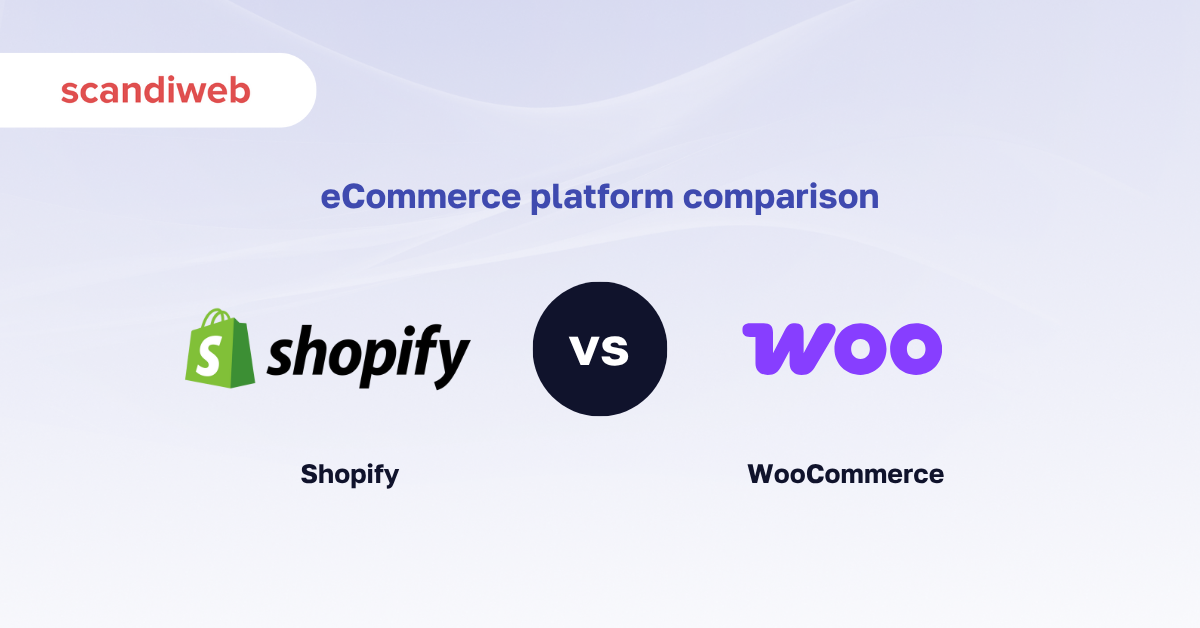


Share on: